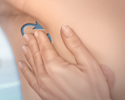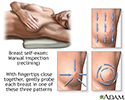Breast self-exam
Self-examination of the breast; BSE; Breast cancer - BSE; Breast cancer screening - self exam, breast self-examA breast self-exam is something a woman does at home to look for changes or problems in her breast tissue. Many women feel that doing this is important to their health.
However, experts do not agree about the benefits of breast self-exams in finding breast cancer or saving lives. Talk to your health care provider about whether breast self-exams are right for you.
Information
The best time to do a monthly breast self-exam is about 3 to 5 days after your period starts. Do it at the same time every month. Your breasts are not as tender or lumpy at this time in your monthly cycle.
If you have gone through menopause, do your exam on the same day every month.
Menopause
Menopause is the time in a woman's life when her periods (menstruation) stop. Most often, it is a natural, normal body change that occurs between ag...

Begin by lying on your back. It is easier to examine all breast tissue if you are lying down.
- Place your right hand behind your head. With the middle fingers of your left hand, gently yet firmly press down using small motions to examine the entire right breast.
- Next, sit or stand. Feel your armpit, because breast tissue goes into that area.
- Gently squeeze the nipple, checking for discharge. Repeat the process on the left breast.
- Use one of the patterns shown in the diagram to make sure that you are covering all of the breast tissue.
Next, stand in front of a mirror with your arms by your side.
- Look at your breasts directly and in the mirror. Look for changes in skin texture, such as dimpling, puckering, indentations, or skin that looks like an orange peel.
- Also note the shape and outline of each breast.
- Check to see if the nipple turns inward.
Do the same with your arms raised above your head.
Your goal is to get used to the feel of your breasts. This will help you to find anything new or different. If you do, contact your provider right away.
References
American Cancer Society website. American Cancer Society recommendations for the early detection of breast cancer. www.cancer.org/cancer/breast-cancer/screening-tests-and-early-detection/american-cancer-society-recommendations-for-the-early-detection-of-breast-cancer.html. Updated December 19, 2023. Accessed February 4, 2024.
Mallory MA, Golshan M. Examination techniques: roles of the physician and patient in evaluating breast disease. In: Bland KI, Copeland EM, Klimberg VS, Gradishar WJ, eds. The Breast: Comprehensive Management of Benign and Malignant Diseases. 5th ed. Philadelphia, PA: Elsevier; 2018:chap 25.
National Cancer Institute website. Breast cancer screening (PDQ) - health professional version. www.cancer.gov/types/breast/hp/breast-screening-pdq. Updated March 28, 2024. Accessed April 10, 2024.
Swartz MH, Nentin FG. The breast. In: Swartz MH, ed. Textbook of Physical Diagnosis: History and Examination. 8th ed. Philadelphia, PA: Elsevier; 2021:chap 16.
US Preventive Services Task Force website. Breast cancer: screening. www.uspreventiveservicestaskforce.org/uspstf/recommendation/breast-cancer-screening. Updated April 30, 2024. Accessed May 7, 2024.
Breast self-exam
Animation
Female Breast - illustration
The female breast is either of two mammary glands (organs of milk secretion) on the chest.
Female Breast
illustration
Breast self-exam - illustration
Monthly breast self-exams should always include a visual inspection, with and without a mirror, to note any changes in contour or texture, and manual inspection in standing and reclining positions to note any unusual lumps or thicknesses.
Breast self-exam
illustration
Breast self-exam - illustration
Monthly breast self-exams should always include a visual inspection, with and without a mirror, to note any changes in contour or texture, and manual inspection in standing and reclining positions to note any unusual lumps or thicknesses.
Breast self-exam
illustration
Breast self-exam - illustration
Monthly breast self-exams should always include a visual inspection, with and without a mirror, to note any changes in contour or texture, and manual inspection in standing and reclining positions to note any unusual lumps or thicknesses.
Breast self-exam
illustration
Female Breast - illustration
The female breast is either of two mammary glands (organs of milk secretion) on the chest.
Female Breast
illustration
Breast self-exam - illustration
Monthly breast self-exams should always include a visual inspection, with and without a mirror, to note any changes in contour or texture, and manual inspection in standing and reclining positions to note any unusual lumps or thicknesses.
Breast self-exam
illustration
Breast self-exam - illustration
Monthly breast self-exams should always include a visual inspection, with and without a mirror, to note any changes in contour or texture, and manual inspection in standing and reclining positions to note any unusual lumps or thicknesses.
Breast self-exam
illustration
Breast self-exam - illustration
Monthly breast self-exams should always include a visual inspection, with and without a mirror, to note any changes in contour or texture, and manual inspection in standing and reclining positions to note any unusual lumps or thicknesses.
Breast self-exam
illustration
- Breast cancer - InDepth(In-Depth)
- Breast cancer(Alt. Medicine)
Review Date: 3/11/2023
Reviewed By: Debra G. Wechter, MD, FACS, General Surgery Practice Specializing in Breast Cancer, Virginia Mason Medical Center, Seattle, WA. Internal review and update on 02/04/2024 by David C. Dugdale, MD, Medical Director, Brenda Conaway, Editorial Director, and the A.D.A.M. Editorial team.










